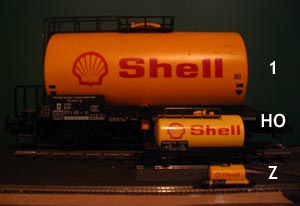
About Gebr. Märklin & Cie GmbH
The firm "Märklin" was founded in Germany in 1859 by Theodor Märklin,
manufacturing toys, dolls' houses etc. but the first "model" trains were not
produced until 1891. Never the less, we are looking at over 160 years of
history in the toy business with forays into mechanical construction sets
similar to Meccano, and also a slot car system ("Sprint")
Nowadays Model trains are the mainstay of the business and are produced in 3
different scales
Without doubt, HO scale is the most popular, and Marklin differentiates itself in this crowded
market by producing trains that run on a centre (3rd) rail system. The centre rail (in the form of small,
not too obvious studs)
acts as a current pickup point for the locos, with the outer running rails
both being at the same (return) potential. This
arrangement neatly circumvents all the reverse loop short circuit problems that would otherwise exist,
and also facilitates such "niceties" as train detection via a small section of
isolated rail, easing the way for control of signals and, in the digital age,
almost any other event or sequence of events limited only by the imagination.
The disadvantage of the 3 rail system is perhaps in its uniqueness: Because the
outer rails are common, all rolling stock is built with conductive wheel sets.
This creates incompatibility with other brands, as the rolling stock creates a
short circuit when placed on "normal" 2 rail track. Regardless, Märklin
has a very large following and among its adherents at least, the advantages of
the simplicity of the 3 rail system far outweighs the disadvantages.
The Three Märklin Gauges . . .
Märklin produces 3 scales of trains, 1 gauge, the biggest at 1/32nd scale, Z gauge, the smallest at 1/220th scale and HO, the most popular size at 1/87th scale.

Märklin also owns "Trix" (since 1997) which produces HO scale models for 2 rail enthusiasts, and N gauge (9mm). More recently (2007) Märklin acquired LGB with its product line of G scale model railways
>> top <<